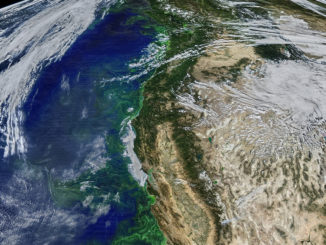
We’re not yet optimizing biofuel production for both economic and environmental factors
Facing the reality of human-caused warming, we now look for ways to reduce the problem so that future generations will not inherit a disaster. So, what can we do now to help the future?
The easiest answer is to use energy more wisely and quit wasting our precious resources. Second, we can increase our use of clean energy, particularly wind and solar power. These are great starts but we will still need some liquid fuels and for those, we can make decisions about the best fuels for the environment. There has been extensive conversation recently about biofuels and how they may help solve the climate problem.
The term “biofuels” has many meanings, but basically they are grown fuels (like corn ethanol) that we can use instead of fossil fuels (like petroleum). While biofuels can be any fuel produced from plant material, historically they have been produced from food crops such as corn and soy. But, new technologies are enabling biofuel production from non-edible gases, wood, and other plant waste material.
The beauty of biofuels is that they suck carbon dioxide out of the air as they grow. When we burn them in our automobiles, we release carbon dioxide, but it is the same carbon that the plants absorbed while growing. Just on that basis, biofuels appear to be zero net emitters.
But this view is too simplistic. It takes energy to grow biofuels; it takes fertilizer, tractors, transportation, and energy to convert the plants to liquid fuels. Planting and growing these crops can also change how much carbon is stored in the soil. And using existing food crops or arable land for biofuel production might lead to deforestation if farms are expanded elsewhere to make up for lost food production.
So, if you want to accurately assess the impact of biofuels, you need to look at what’s called a “life cycle analysis,” which basically means the effort it takes to grow the crops, harvest them, convert them to fuel, transport them to distribution sites, and combust them.
I have done some research in this area. Back in 2009, I did a study with my former student Fushcia-Ann Hoover, and we compared different feedstocks for ethanol. You can have corn, soybeans, sugarcane, switchgrass, poplar trees, and others. What is the best crop? Which is easiest to grow? Which is best for the environment?
What we found, way back in 2009, is that if non-commercial crops were grown, you could actually end up with fuel that was significantly cleaner than petroleum. The trick was finding clean crops that don’t need a lot of fertilizer, water, and other inputs. Corn ethanol for instance is not the best choice. You need so much water, fertilizer, and other costs, that it almost doesn’t make it worthwhile. But other crops such as switchgrass, grown on marginal lands, have real a potential. Marginal lands are farmlands that are not optimal for growing crops.
Our conclusion in 2009 was straightforward. Don’t use good cropland for biofuels. Rather, use marginal croplands, with minimal water and fertilizer, to create plants that can be converted to biofuels.
But our conclusion wasn’t the end of the story. There are other details that researchers should consider. For instance, how far from the croplands to the refinery? How much energy is needed to transport the fuels? All these issues matter and they were the focus of a recent research paper just published inNature Energy. This study used an actual biofuel refinery located in Kansas for the basis of the study. And the authors counted all the emissions that occur during the lifecycle analysis of these biofuels. They realized that marginal croplands give lower yields, so there are competing issues of productivity and greenhouse gas reduction.
Then there’s the complicating factor of economics. The price of biofuels and the price of greenhouse gases matter. If society is willing to pay a small pollution charge like a carbon tax, it supports the producers of clean energy. But if society doesn’t put a premium on clean energy, it’s harder for clean industry companies to thrive.
In the new study, the authors discovered something fascinating. The found that the choices a farmer may make regarding what land to use for biofuels and how much fertilizer to use depend strongly on the price of clean fuels and the cost of greenhouse gases. Simply put, it we put a reasonable price on carbon pollution, farmers will be able to grow switchgrass, poplars, and other species, reduce greenhouse gases, and make money.
But, if there is no cost to carbon pollution, farmers will be motivated to spend more money on fertilizer and that, in the end, will lead to more emissions. While all the scenarios resulted in large emissions reductions compared to gasoline, the reductions were especially large for the scenarios that included a carbon price.
So, there is a delicate balance. The balance is made more clear when we realize that farming location matters. If biofuels are grown close to refineries, less pollution is created in transporting the fuels to the refinery. However, this limits cropland choices to those nearer to refineries.
With this balance of competing factors, the authors find room for improvement; currently we are not optimizing the performance in terms of both economic and environmental factors. In order to do this right, we have to balance all these mentioned issues. We can’t just focus on transportation costs, fertilizer costs, and land quality costs; we have to consider these costs all together as a system.
I spoke to the lead author of the paper, Dr. John Field, from Colorado State University and asked him about the significance of this work.

Agriculture is being challenged by increasing food demand, and changes to regional climate. On top of this, most plans to combat climate change rely on the agricultural sector to increase carbon storage in soils, and to produce raw materials for the large-scale production of biofuels and power. Modeling studies like ours attempt to predict on a farm-by-farm basis where the best opportunities for biofuel crop production and soil carbon storage lie, how much they might cost, and how those two goals trade off.
Our results suggest that biofuels can have a wide range of environmental outcomes depending on exactly where and how those crops are grown, but climate benefits can be increased at relatively low cost.
This is another great example of clean energy technologies that will help us solve the climate problem while continuing our use of fuels that drive the economy. It’s a win-win situation.
Visits: 1




balance of competing factors matters, waiting to see the results